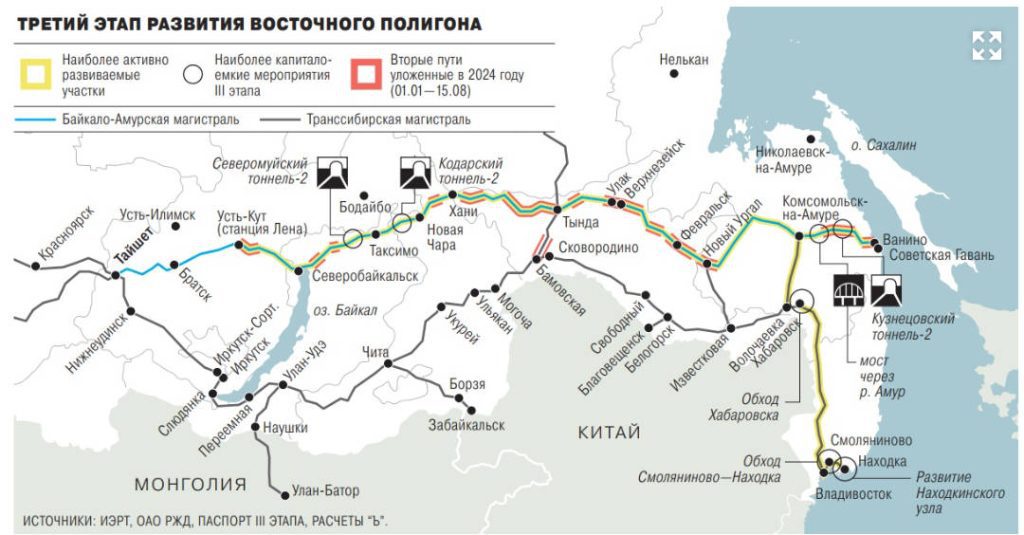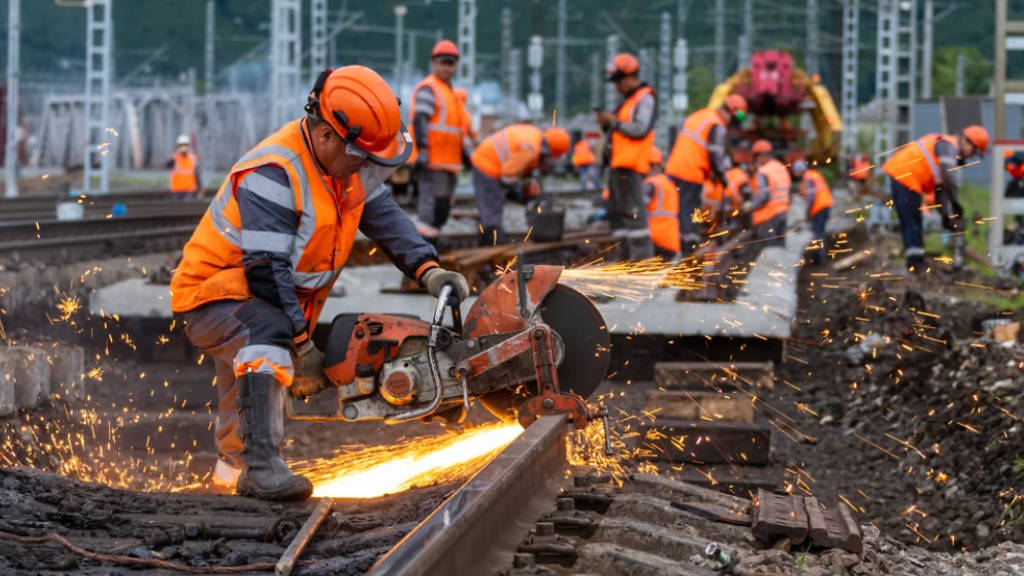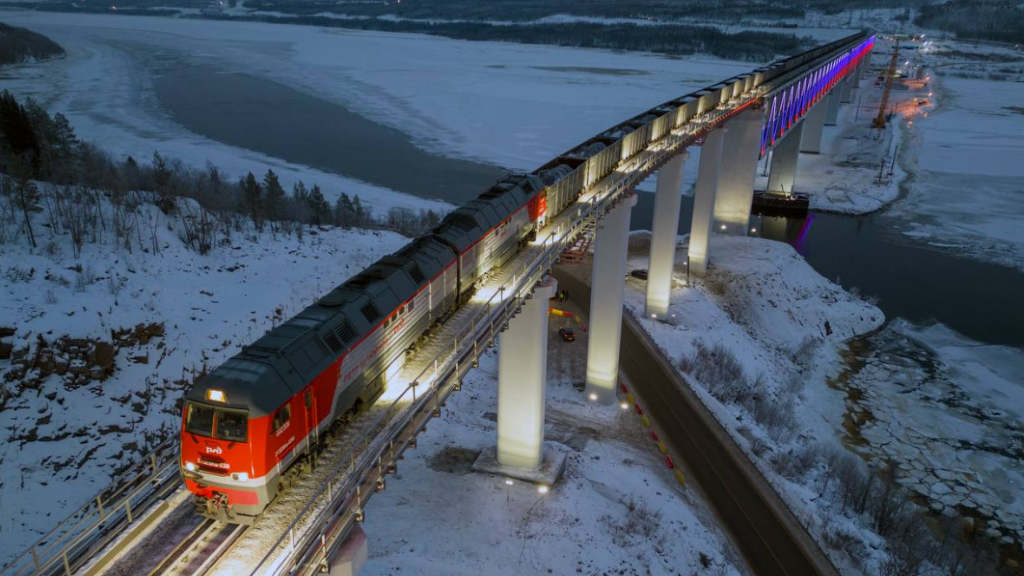The third expansion stage of Trans-Siberian and Baikal-Amur Mainline (BAM) railway has been approved by the Russian government, allowing the Russian Railways to immediately invest in design and survey work on these extensions. This includes labour-intensive work involving the laying of over 2,000 km of new tracks, three new tunnels for the accompanying road highway, a bridge across the Amur River, and work to deal with existing bottlenecks along the eastern section of the Trans-Siberian Railway.
The goal of the project is to achieve carrying capacity by the end of 2030 of 210 million tonnes, increasing to 270 million tonnes by 2032. The total cost of this third stage amounts to ₽3.74 trillion (US$38 billion).
Work is also planned along the Trans-Siberian Railway to lengthen almost all of the existing stations to accommodate wagons stretching for up to 2km in length, as Russian Railways intends operating double container trains, which can weigh up to 7,100 tonnes.
With Russia’s trade with Asia significantly expanding, the government and Russian Railways took advice from shippers, as a result of which some fine tuning of the routes were taken into account.
Leonid Shlyakhturov, the executive director of FESCO Integrated Transport, says that the development of the Trans-Siberian Railway is currently vital for the Russian transport industry as a whole, with modernization of the two railway arteries especially relevant, given the current high load on the network of Russian Railways, the relatively low level of cargo containerization and further economic growth, both in the Far East and in other regions of Russia.
During H1 2024, the Russian Far East container turnover volume amounted to 44% of Russia’s total, however the existing capacity of the region does not allow for the full utilization of existing Far Eastern port facilities. Cargo stations will also be expanded, with the building of regional parks and bypass routes.
The main developments however will continue to be focused on expanding the BAM, taking 72% of all investments. But these require careful planning, as construction delays can occur because the new tracks are being built alongside existing rail conditions, and these also cannot be delayed or diverted. That means that construction can only take place in specific timetable windows, and builders must share this time with repairmen.
Russian Railways are hiring about 30,000 workers to build these routes, with labour shortages somewhat alleviated recently as the Elga Coal projects Pacific Railway is close to being completed, having intensified work this year. Personnel are also being recruited and trained specifically in railway construction engineering.
Construction Obstacles
Other work is being subcontracted, such as the construction of about 1,700 km of secondary tracks, over 700 bridges and 600 culverts. There are other natural difficulties to overcome – the severe winter climate, seismicity, and permafrost. To preserve the permafrost, cooling sketches are utilized, to stabilize the tracks, with the laying of modern geo-composites at the base of the railway. To protect the tracks in areas at risk of avalanches and rockfalls, reinforced structures on unstable slopes are being installed. In addition to this, the BAM is a smart railway and will use blockchain technologies to secure wagon contents. That also makes it a unique testing ground for testing new solutions and technologies not only in terms of construction, but also in the digitalization of movement. These include Russian designed interval control systems for train traffic, to allow routes to work effectively in even difficult weather conditions with minimal maintenance.
Financing
Another innovation is the inclusion in the construction program of a public-private partnership and funds coming not from the investment program of Russian Railways, but from loan funds raised by the contractor.
This includes the construction of four expensive facilities, necessary to radically increase the carrying capacity of the BAM. These are the Severomuysky and Kodarsky tunnels of the East Siberian Railway, the second Kuznetsovsky tunnel of the Far Eastern Railway and the bridge across the Amur in Komsomolsk-on-Amur. The BAM project estimates the cost of these at a total of ₽500 billion (US$5.5 billion). These facilities will be built according to a payment by installments agreement spread over ten years. In this scheme, the contractor seeks funding and builds facilities, but does not participate in their operation. Russian Railways will pay for work within ten years after the facilities are put into operation. In March this year, Russian Railways signed general contract agreements with BTS-Most for the construction of these facilities. BaltTransServis (BTS) was founded in 1999 in St Petersburg and since then has become one of the largest private operators focusing on rail transportation.

Tunnelling
All the tunnels to be constructed and receive back up have unique characteristics. The Kodar tunnel, which is just 1.98 km long, runs under the Kodar ridge, and is the highest of the BAM tunnels.
The Kuznetsov tunnel, crossing the Sikhote-Alin ridge, was originally opened in 1945, but its capacity no longer meets the needs of increased cargo traffic. A second ‘New Kuznetsov Tunnel’ has already been completed.
The Severomuysky tunnel, at 15.3 km, is the longest tunnel on the BAM, and can carry 16 pairs of trains per day, or 16 million tonnes per year. The need now is to expand it to 100 million tonnes through the construction of a second tunnel.
The Russian BRI
These Russian Railways investments into the BAM and Trans-Siberian Railway are among the largest railway development projects in the world today – and will operate in markets that will pave the future direct of Russian trade well into the rest of this century. Their completion will also set up Russian Railways, just as it did for China’s various Railway engineering companies, for the export of their technologies on a global basis.
In essence, these type of domestic investments into infrastructure mirror the Chinese Belt & Road Initiative, where domestic infrastructure investments made by Beijing during the 2000’s were later exported around the world to assist China develop sustainable supply chains for both exports and to secure its import needs. The BAM – Trans Siberian railway developments are Russia’s version of this exact same concept – the commencement of the Russian Belt & Road Initiative.
Further Reading
Baikal-Amur Rail To Be Developed For Russia’s AsiaPac Markets





